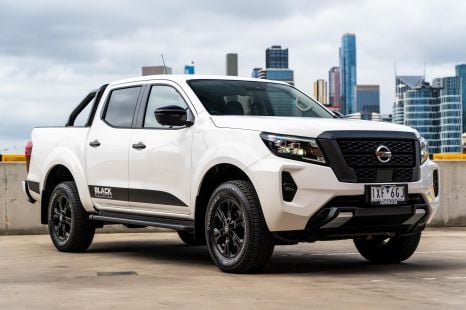

Josh Nevett
3 Months Ago
There are many takes on the Ford Ranger theme, but the XLT V6 4x4 pick-up could be one of the best for a dual-purpose family ute.



Quickly see how this car stacks up against its competition. Select any benchmark to see more details.
Take advantage of Australia's BIGGEST new car website to find a great deal on a Ford Ranger.
There’s a Ford Ranger for every buyer out there, it seems.

The Blue Oval has maximised the number of variants available with the new-generation range, and it’s made it harder for some of the existing best options to shine quite as brightly as they used to.
Take the XLT model, for instance. In the last-gen Ranger line-up, the XLT was arguably the perfect spec for a buyer who wanted a dual-cab ute with some nice features, but not too much bling or audaciousness – a ute you could use for dual purposes, in other words: work and play.
So, we thought we’d spend some time in the XLT grade with the V6 turbo-diesel to see if the new-generation version is still the sweet spot, or if you should consider one of the other models in the range?
Is the 2024 Ford Ranger XLT V6 4×4 a winner? Let’s find out!
The XLT is the cheapest way into a Ranger V6 diesel dual-cab (from $67,590), but the cab-chassis version is even cheaper than the pick-up – could be a good hack for those who know they’ll fit their own canopy or tray.

If you don’t need the V6, you can save yourself just under four grand if you can settle for the four-cylinder Bi-Turbo instead.
What other utes could you consider if you were looking at a V6? The obvious (and only) alternative is the Amarok, but there’s no sub-$70,000 Amarok V6 available – the Style 4×4 grade is $73,740 plus on-roads. While it has a number of features you don’t get in a Ranger XLT, that price point won’t be attainable for everyone.
Indeed, the question you might want to ask yourself is whether you could be better off adding a little more to your finance payment and getting a Ranger Sport, which has a number of added niceties for $2500 more.
The extras include 18-inch alloy wheels, dark exterior accents, two front-mounted tow hooks, skid plate, front floor mats, drive mode selector, wireless phone charging, leather upholstery, and an eight-way electrically adjustable driver’s seat.
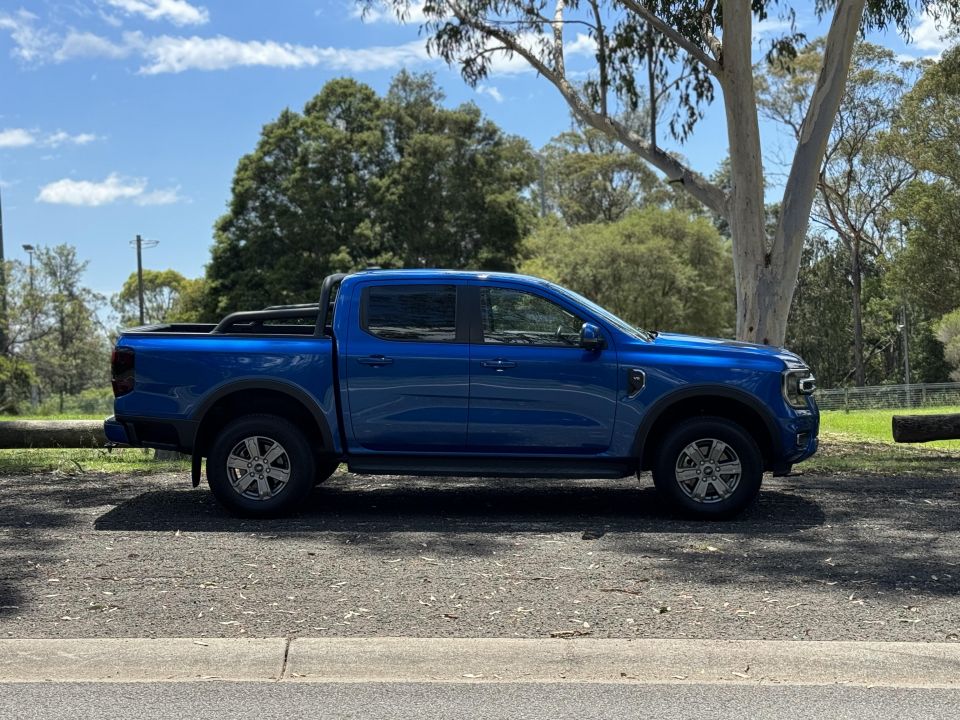
2024 Ford Ranger V6 pricing:
Prices exclude on-road costs
The XLT isn’t as flashy or fashion-focused as some of the models that sit above it, with a more simple and functional interior treatment compared to the Sports and Wildtraks of this world.
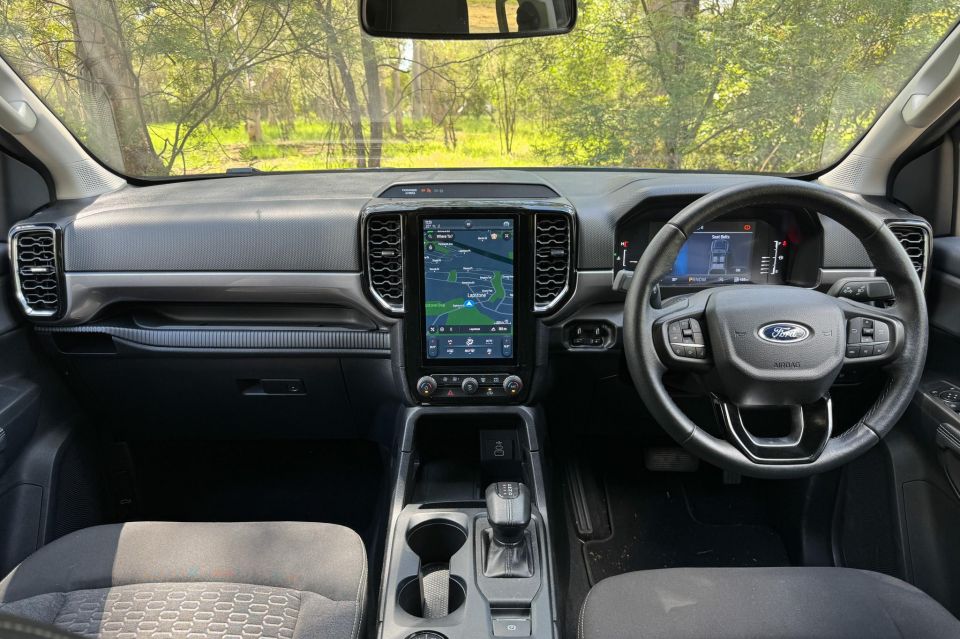
As a result, the XLT doesn’t get the bigger touchscreen media system, though the standard-fit 10.1-inch portrait display still comes with satellite navigation, plus wireless Apple CarPlay and Android Auto.
Thankfully though, the controls are mostly very simple – and that’s aided by the fact that you do get a row of ‘hard’ touch controls in a panel at the bottom of the screen for your climate controls, plus there’s also a secondary manual array for climate controls below the screen too.
All of that just means that this is a fast, simpler climate system to deal with than you find in some other utes (like the Amarok).
I find the media system menus are mostly intuitive; although, it will take some learning to figure out where everything is because there are a lot of different controls for car functions through the screen.
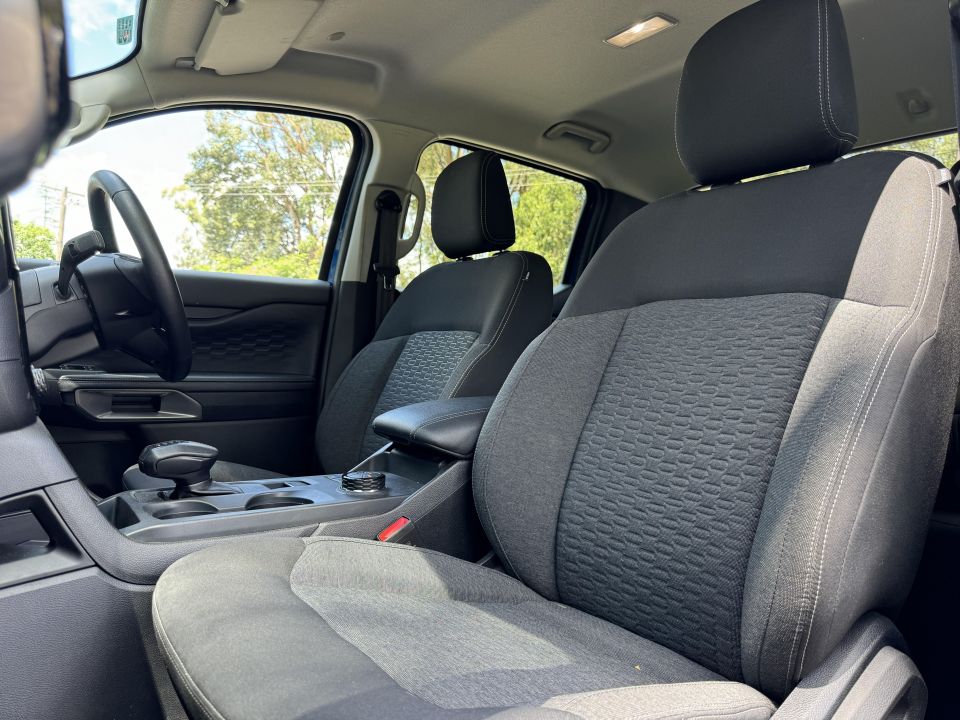

If you plan to tow for example, there is a series of different tow settings and controls that you can use through the screen, including setting up different trailers as favourites that will allow the safety systems to figure out what you are towing. You just input vital measurements for the car to adapt to suit the towed load.
While the digital instrument cluster is not the full-scale 12.3-inch one, it is still a fully-digital display with easy access to different menus, including trip computer and other settings and displays.
The material finishes in the XLT grade aren’t quite as special as the higher grade models, and the example on test did have a few misfitted plastic sections around the cabin as well.
There is soft material on the elbow pads on the doors, and on the centre console bin between the seats, and a harder plastic finish on part of the door trim as well. The dashboard has some hard plastics as well.
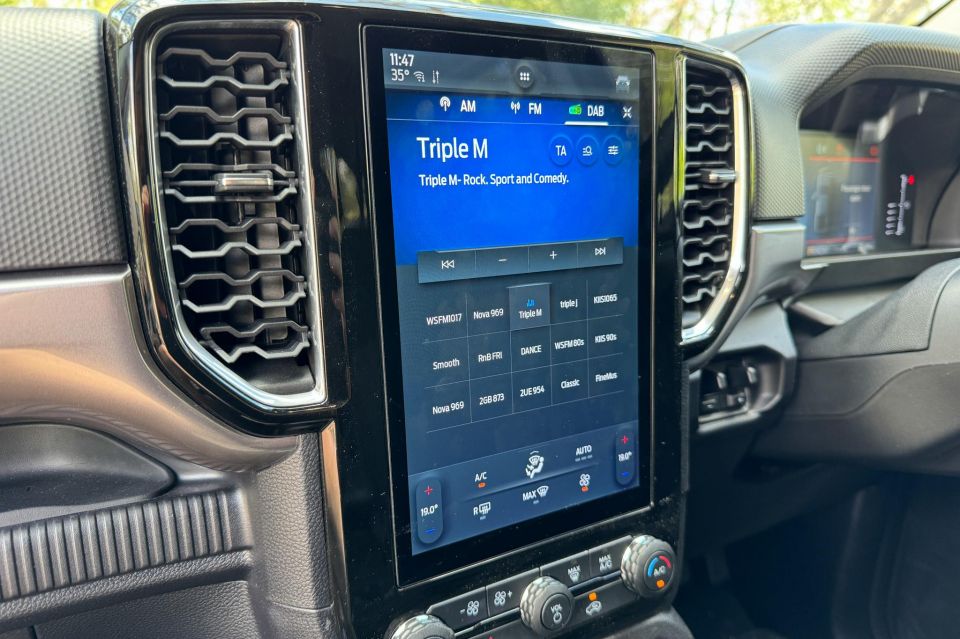

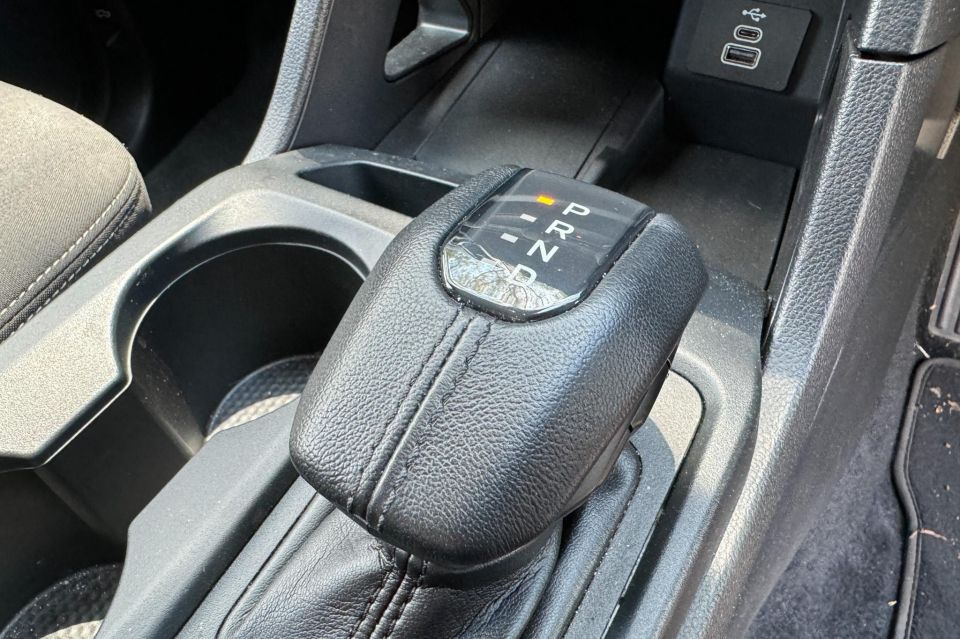
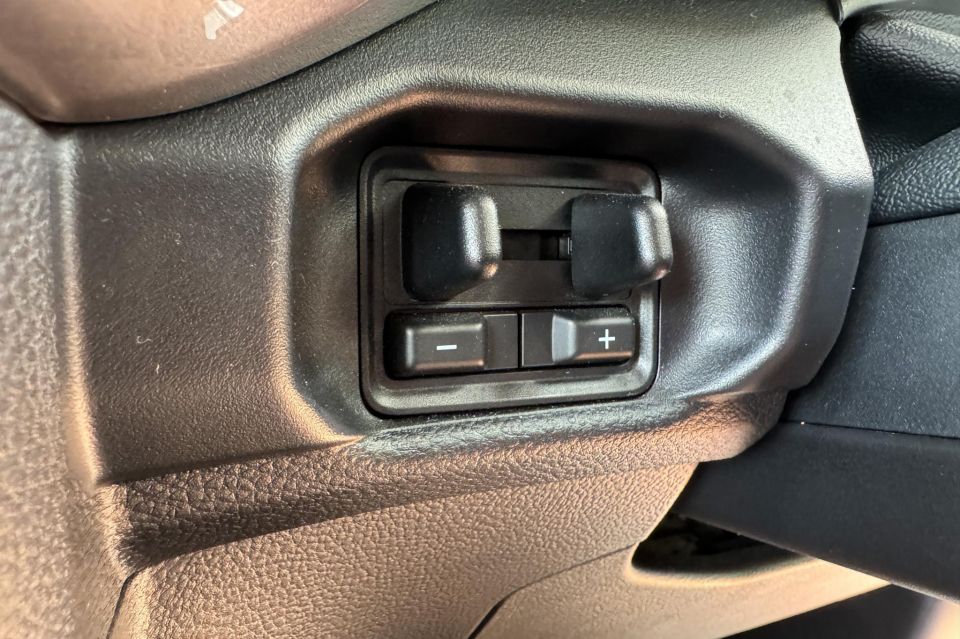
While there is a little storage shelf section in front of the passenger, this grade doesn’t get pop out cupholders at the edges of the dashboard like some others. Instead they are just storage holes – which might be good for a wallet.
This version does have a spot where your phone can sit below the screen, but it isn’t a wireless phone charger – seems such a silly shortfall. There is another storage cubby nearby, a pair of cupholders between the seats, a centre console bin which is a decent size and features a 12-volt port as well, and there are bottle holders in the doors, too.
All the controls are relatively easy to get your head around – especially if you had an existing Ranger – and I find that the front seat experience is actually really good, even though it does have cloth seat trim which doesn’t necessarily feel as special as it could.
It also has manually adjustable seats rather than electric and there’s no seat heating. Overall, it does feel a bit on the budget side.
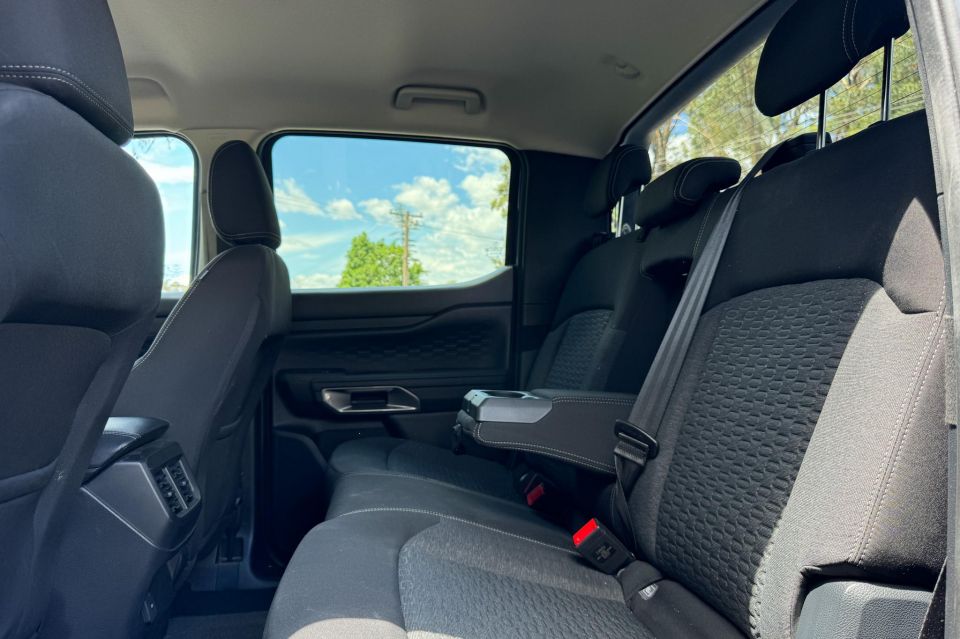
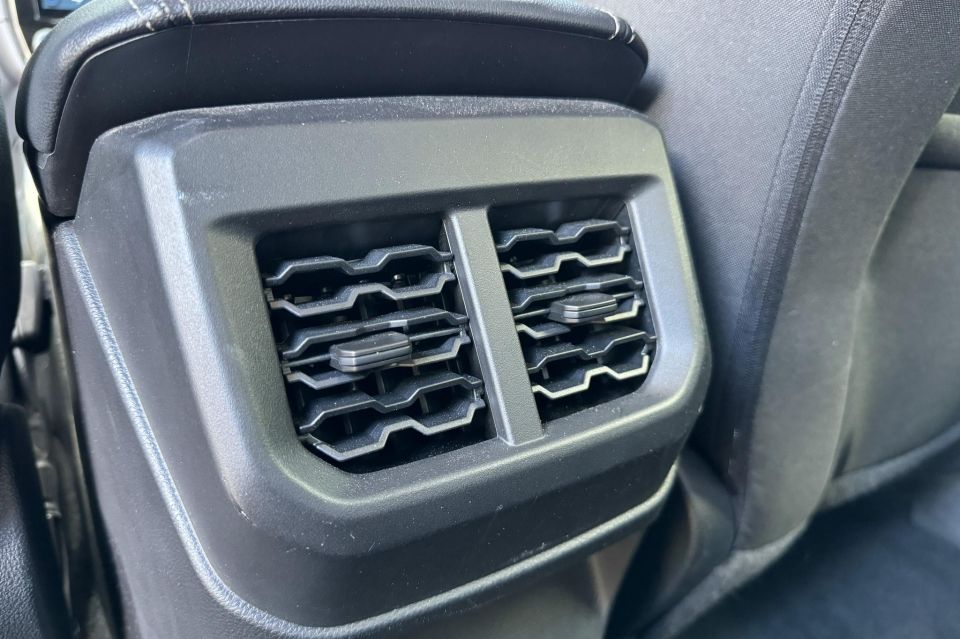

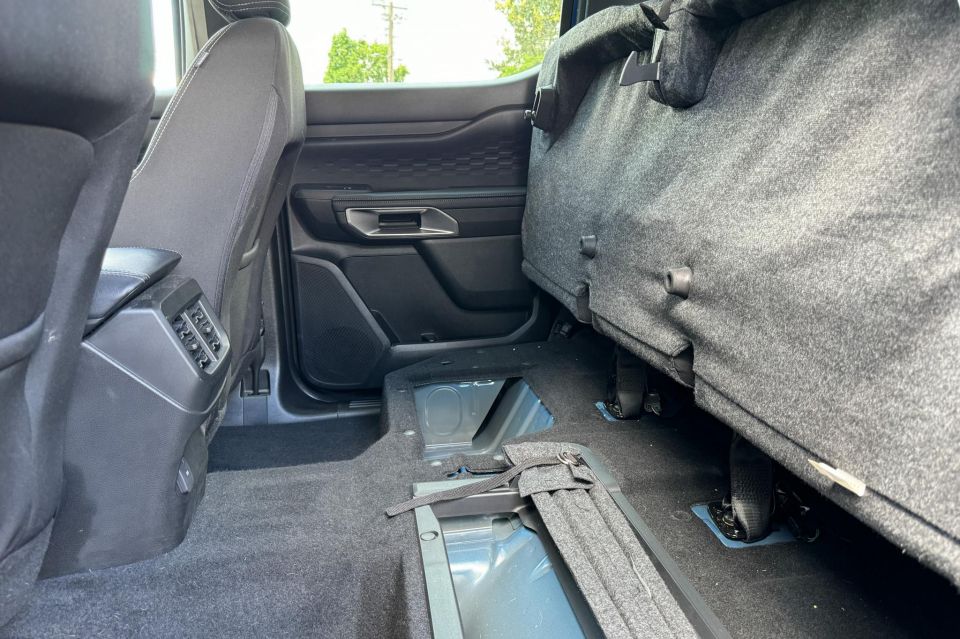
At least the rear seat experience is decent. With the driver seat set for my driving position (182cm / 6’0”) I had enough room to be comfortable, with my knees only just brushing the seat ahead. There’s good foot, head and shoulder room as well.
Three big adults across the back would be a bit of a squish, but the transmission tunnel isn’t too big of an intrusion, and if you plan to use the back seat for rugrats instead it will be easy enough to fit two child seats in the back comfortably.
Speaking of child seats, you’ve got a pair of top-tether points behind the seat back, which is better than some utes which have just one centrally-mounted tether loop.
However, the Ford’s tether points are a little bit frustrating to attach to a seat, as you never feel as though it’s as tightly restrained as you might wish it was. There are ISOFIX points in the window seats as well.

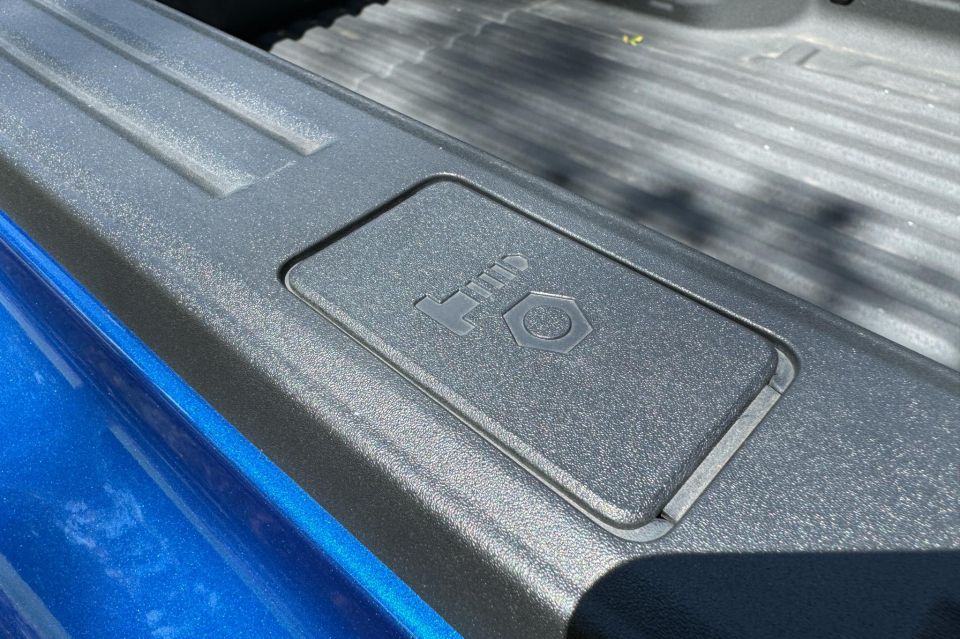
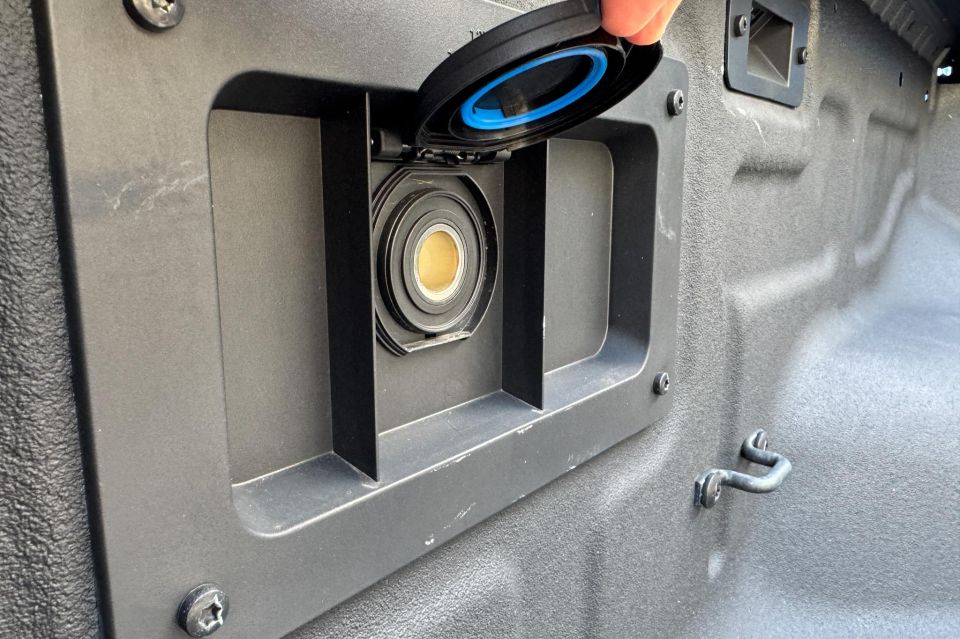
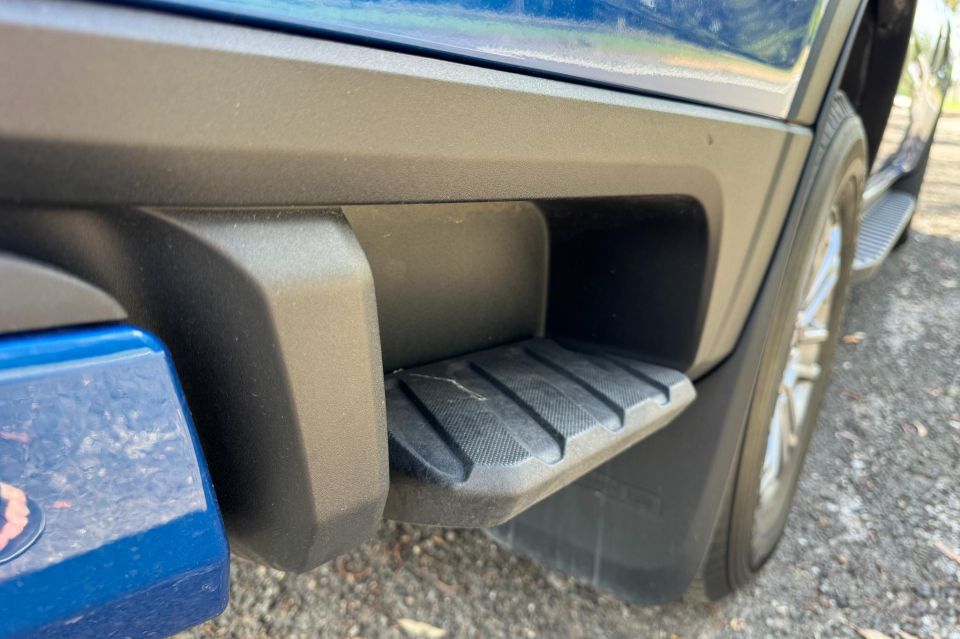
Storage-wise there’s an armrest with a pair of cupholders, a pair of map pockets, and decent door pockets too. There is also a pair of directional air vents, and a 12-volt plug which you could fit a USB plug into. Otherwise there are no USB ports, and no 230-volt power point in this spec.
If you aren’t planning to use the back seat all the time, there is the capability to fold up the seat base (one piece) to allow extra safe and secure dry storage in the cabin.
Now, there’s no boot space to discuss, so let’s talk about the tub. It’s 1464mm long, 1520mm wide and 1224mm between the arches – meaning it’s large enough to cope with a standard Aussie pallet (1165mm) – and 525mm deep. What that all equates to is ample space for camping gear or luggage for a family trip away.
This XLT is optioned with the spray-in tub liner and also the Touring Pack, so it does have some additional tie-down points in the tub, and the tub also has a 12-volt outlet. There are twin LED lights on the edges of the tub too.
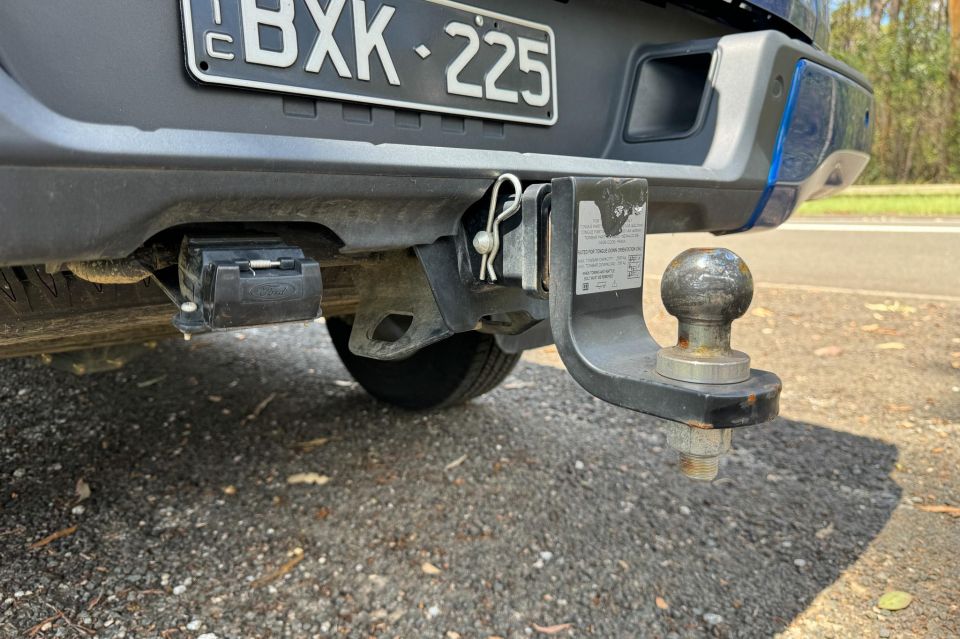

What I do like about this spec is that it has a nice assisted closing to the tailgate, but – annoyingly – it really does clang down when you open it – as the tailgate is not piston assisted. On the tailgate you’ll also find a measuring tape and a couple of clamp points, so you could use it as a mobile workbench if you needed to.
At the rear sides of the tub, there are step sections to allow you to climb in a little more easily, and they can be very handy, especially when you’re trying to secure a load. There is also a full-size spare wheel under the tray floor.
This version of the XLT is fitted with the ‘Lion’ 3.0-litre V6turbo-diesel, which produces 184kW and 600Nm.
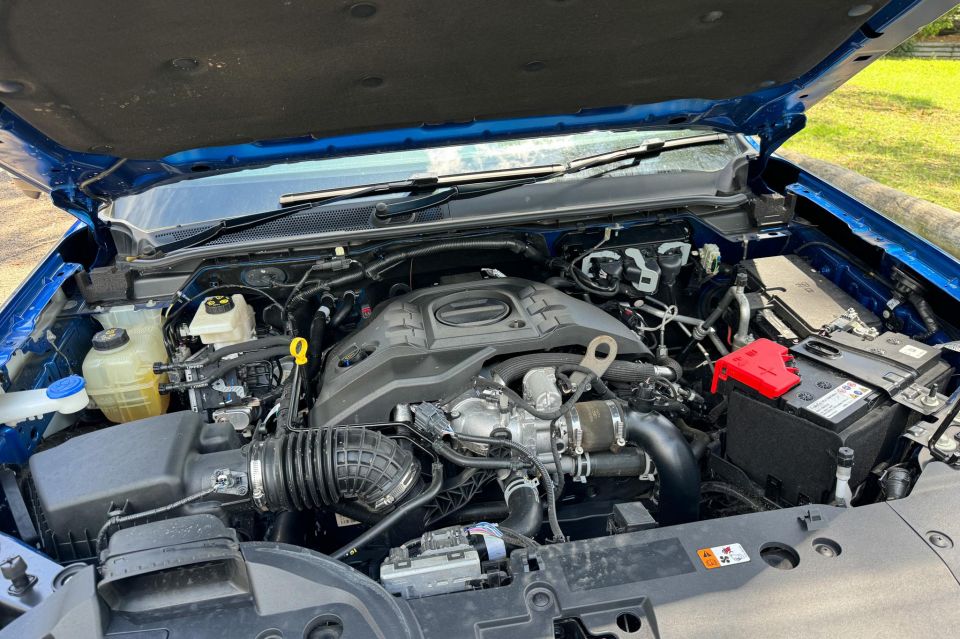
It is mated to a 10-speed automatic transmission, with drive sent through a full-time four-wheel drive system. That means you’ve got a 4A mode for the gearbox that will apportion torque to front or rear axles (or both) as required. Or you can run it in 2H, 4H or 4L low-range as needed.
Let’s talk about capability – the Ranger has a towing capacity of 750kg for an unbraked trailer, and 3500kg for a braked trailer. And remember, the XLT comes with a towbar and wiring harness, and it has an electronic brake controller fitted as standard too. Ford might sting you $50 for a towball, believe it or not.
The payload is rated at a tax-friendly 1024kg for this spec, which might be the reason you choose it over the higher-grade models – talk to your accountant to find out why!
Kerb weight is 2306kg, it has a gross vehicle mass (GVM) of 3280kg, and the gross combination mass (GCM) is 6400kg. So you’re going to have to be careful if you actually plan to tow a 3500kg trailer behind.
As for fuel economy, the Ranger XLT V6 has an official combined cycle number of 8.4 litres per 100km, and over a few weeks of daily driving with some odd jobs thrown at the Ford, I managed at return of 9.6L/100km.
The more time I spend in a V6 Ranger, the more I find that this is a fantastic powertrain for this application.

It offers immense pulling power from low in the rev range, and makes hard work feel easy.
Part of that comes down to the fact that it does have a pretty clever 10-speed automatic transmission, which – apart from having a stupid shifter – is a smart thing, and will allow you to make the best use of this V6 powertrain in almost all situations.
If you don’t want it to be a 10-speed automatic, you can use the lockout function (known as Progressive Range Select), which will allow you to make this vehicle behave as a four-, five-, six-, seven-, eight- or nine-speed auto. It means you can tailor the drive to the situation you’re in.
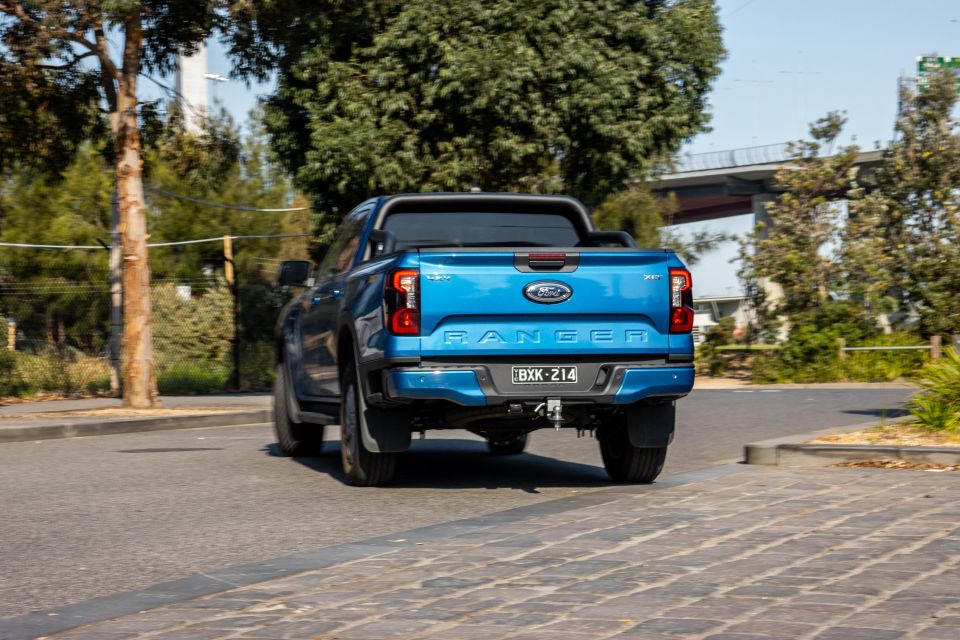
There is also a manual mode if you wish to take matters into your own hands – I have when I’ve towed with this vehicle in the past. But it isn’t by way of paddle-shifters, it’s still just a toggle switch on the gear selector.
Beyond the excellent powertrain, the Ranger still remains the best ute to drive in general terms.
It has a fantastic level of control, comfort, and compliance when it comes to the suspension, and it really does feel like it’s made for Australian roads – funny that!
While it might feel a little soft for some ute customers, that cushy suspension tune makes it all the more enjoyable as a daily driver. It really does deal with urban, freeway and highway cruising, or even country road hustling without much fuss at all, which is unusual for this type of vehicle.

Find out more about the car
Remember it is a ladder-frame, body-on-chassis, serious off-road vehicle that’s designed to tow 3.5 tonnes and cope with a tonne in the tray as well, and the fact that they’ve managed to make it drive better than some mid-size SUVs – that’s a massive hat tip to Ford.
The steering is excellent, with a nice light action to it at low speeds, which makes for easier parking and will ensure it’s less of a battle after a day on the tools. At higher speeds it does develop a level of reassurance and weightiness, too.
There’s not too much to complain about when it comes to refinement, either. This is a V6 diesel ute that has a nice engine warble to it, and thankfully it’s not too rattly or vibey at idle, nor at high-speed.
There’s not too much in the way of road noise intrusion; although, the large side mirrors do have a bit of a job cutting through the air, so you can hear them at times.
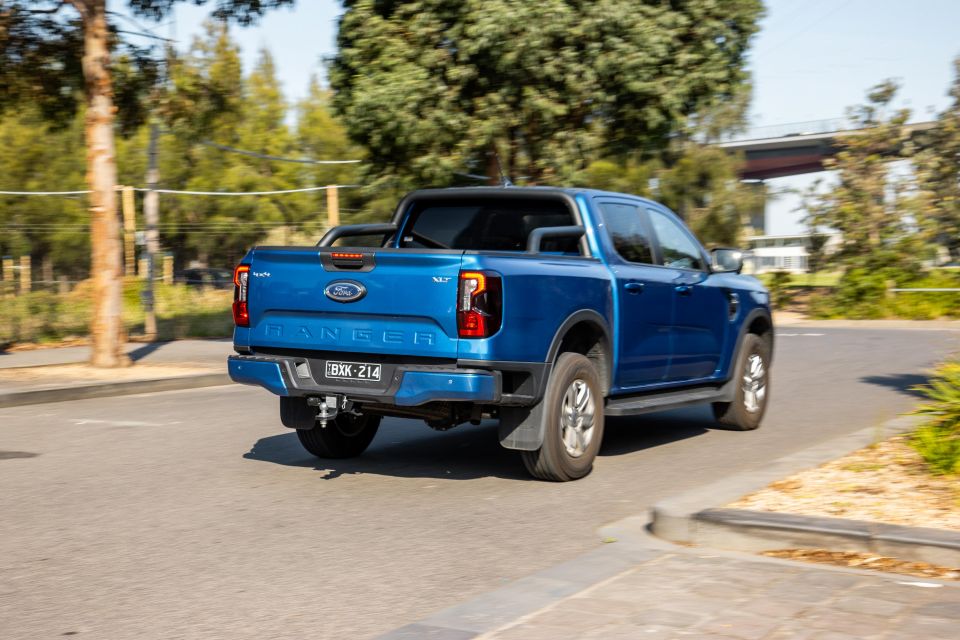
I would say that if you’re weighing up whether to spend any extra on your XLT, the surround-view camera system as part of the Touring Pack is a must, in my opinion. It has multi-view modes, and the top-down view really does help you get a good view of your surroundings.
This is a fantastic ute to live with, and it will do the job for those who are looking for a dual cab that can do the dual-purpose thing.
This was never intended to be a towing test or a 4×4 review, so check out our other coverage of the Ranger dealing with those situations. It really is a jack of all trades.
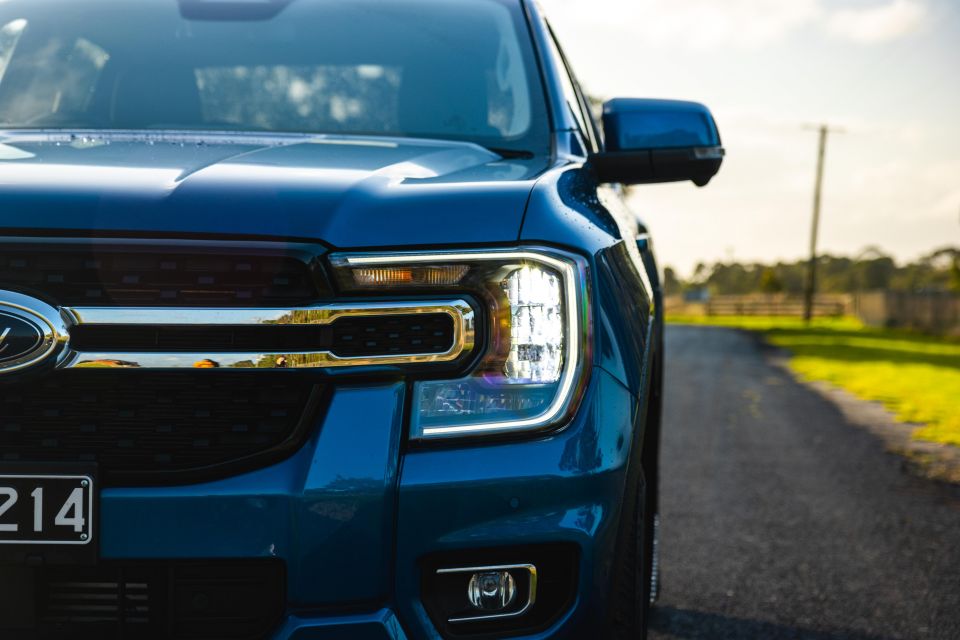



Ranger XLT highlights:


The optional Touring Pack ($1295) adds a surround-view camera, cargo tie-down hooks and puddle lamps.
You can also opt for a spray-in bedliner (in lieu of plastic tub-liner) for $400, and if you wish there’s an upgrade available to all-terrain tyres for $500.
Colour choices include the no-cost solid Arctic White, while the Blue Lightning prestige option here is $700, as is Shadow Black, Meteor Grey, Sedona Orange and Aluminium silver.
The Ford Ranger wears the maximum five-star ANCAP safety rating based on 2022 testing.
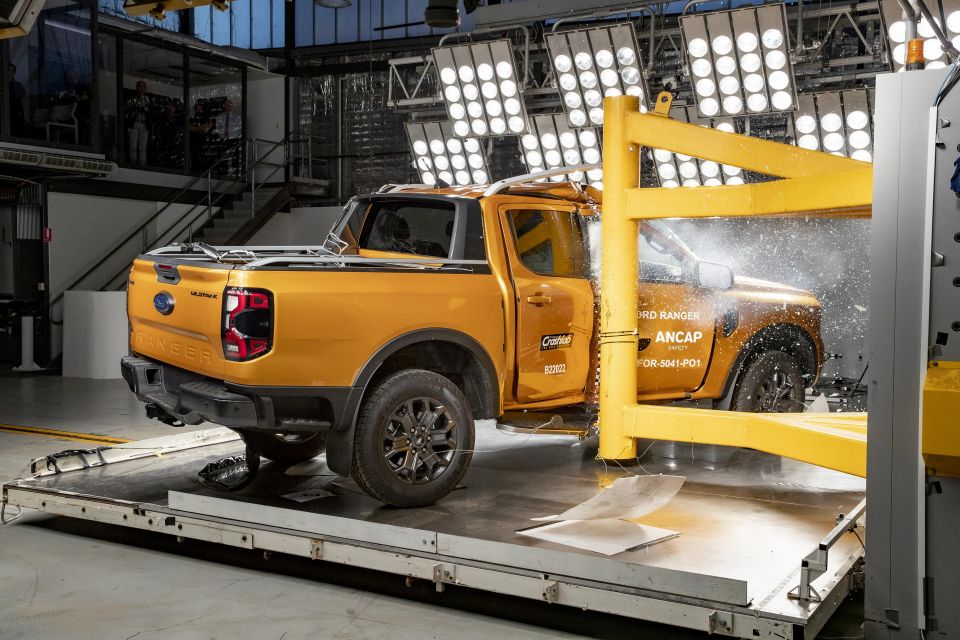
Category scores included 84 per cent for adult occupant protection, 93 per cent for child occupant protection, 74 per cent for vulnerable road user protection, and 83 per cent for safety assist.
Standard safety equipment includes:
The Ranger has nine airbags fitted, including dual front, front side, front centre, driver’s knee, passenger knee, and full-length curtain coverage.
The 2024 Ranger is covered by a five-year, unlimited-kilometre warranty, like the rest of the Ford range.

There are servicing considerations to keep in mind. It has intervals of 12 months/15,000km, which is better than a Toyota HiLux (six months/10,000km) but not as generous as a Nissan Navara (12 months/20,000km).
There’s four-years of capped-price servicing, and the first four visits will cost just $329. Ford offers up to seven years of roadside assistance if you maintain your vehicle with the brand.
The Ranger XLT is going to be a great fit for buyers who want the V6, but don’t want some of the blingy bits you get if you spend a little more on the Sport grade.

Personally, I’d invest the extra to get the niceties you find in the Sport, because leather trim, electric seat adjustment and more user-friendly features make it really appealing – and it’s still got more than a 1000kg payload, too.
Even so, if XLT is what floats your boat, the V6 version is going to be a great choice.
Click the images for the full gallery
BUY: Ford Ranger MORE: Everything Ford Ranger
Take advantage of Australia's BIGGEST new car website to find a great deal on a Ford Ranger.
Matt has more than a decade of experience in automotive journalism, and loves exploring the pros and cons of new cars, delving into deep-dive industry stories, and going for a drive just for the fun of it.


Josh Nevett
3 Months Ago
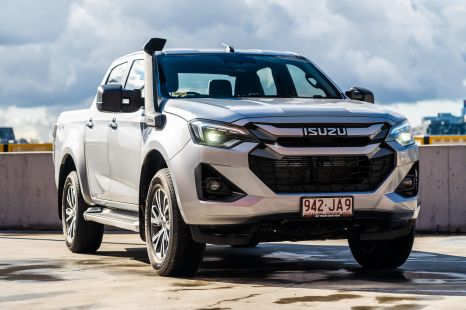

Max Davies
2 Months Ago
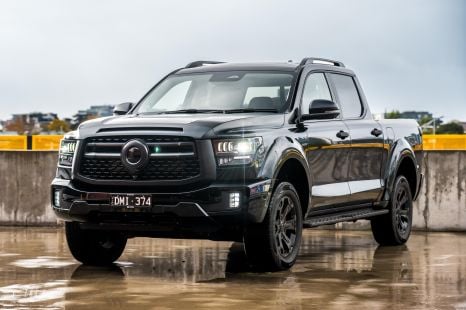

James Wong
2 Months Ago
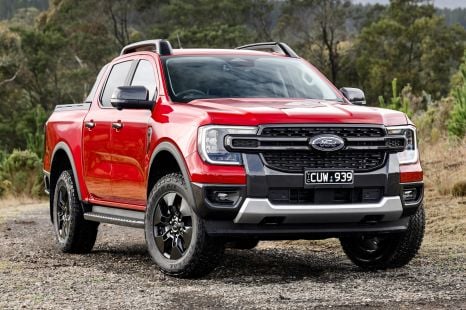

Max Davies
2 Months Ago
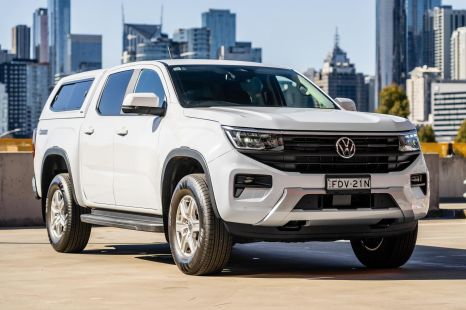

Max Davies
23 Days Ago
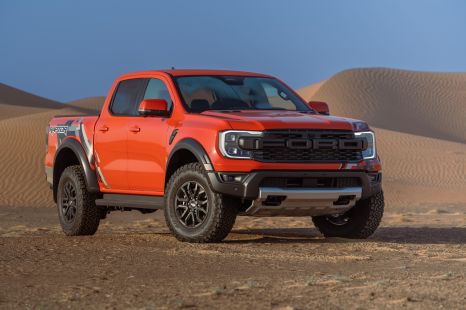

Damion Smy
19 Days Ago